The next-gen MacBook Pro with Retina Display Review
by Anand Lal Shimpi on June 23, 2012 4:14 AM EST- Posted in
- Mac
- Apple
- MacBook Pro
- Laptops
- Notebooks
Battery Life
For much of the past year I haven’t been pleased with just how good Apple’s caching has become both on OS X and iOS. Aggressively caching our test web pages produces artificially inflated battery life numbers and that’s no fun for anyone. I’m happy to say that I’ve fixed that problem with our OS X battery life tests.
The suite is completely redone although conceptually it’s quite similar to what I’ve run in the past. I have three separate workloads: light, medium and heavy, each one representing a different stress level on the machine and all three giving you a decent idea of the dynamic range of battery life you can expect from one of these notebooks. All three tests are run with the displays set to 100 nits (a little above the halfway brightness point on most MacBook Pros).
The light and medium suites are inherently related - they use the same workload and simply vary the aggressiveness of that workload. The light test hits four different websites every minute, pausing for nearly the entire time to simulate reading time. Flash is enabled and present on three of the sites. The long pause time between page loads is what really makes this a light test. Web browsing may be the medium for the test but if all you’re doing is typing, watching Twitter update and maybe lazily doing some other content consumption this is a good representation of the battery life you’ll see. It’s a great way of estimating battery life if you’re going to be using your notebook as a glorified typewriter (likely a conservative estimate for that usage model).
The medium test hits the same webpages (Flash and all) but far more aggressively. Here there’s less than 10 seconds of reading time before going onto the next page. It sounds like a small change but the impact on battery life is tremendous.
Both the light and medium tests are run in their default state with processor graphics enabled, as well as with the discrete GPU forced on. I run with the dGPU on as well because it’s far too often that a single application open in the background will fire up the dGPU and contribute to draining your battery. The goal here is to deliver useful numbers after all.
The final test is very similar to our old heavy multitasking battery life tests, but with some updates. Here I’m downloading large files at a constant 1MB/s from a dedicated server, while playing back a looped 1080p H.264 movie (the Skyfall trailer) all while running the medium battery life test. The end result is a workload that gives you a good idea of what a heavy multitasking usage model will do in terms of battery life. I’ve found that OS X tends to fire up the dGPU anyway while running this workload so I saw no reason to run a separate set of numbers for processor and discrete graphics.
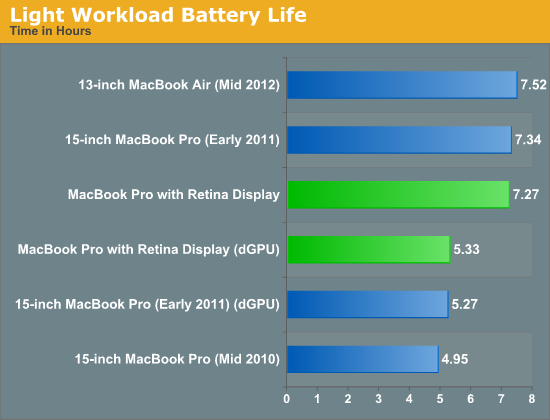
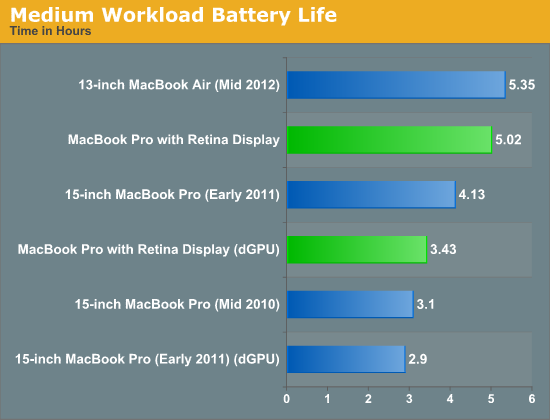
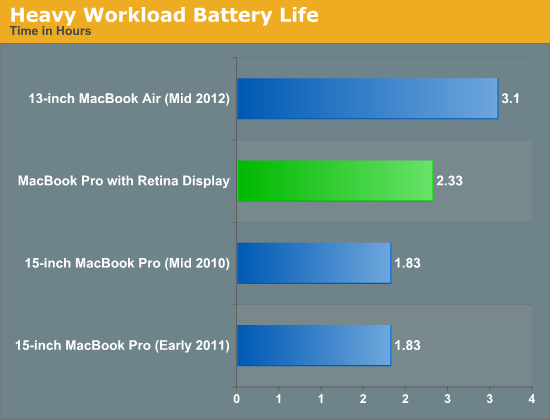
Overall the rMBP pretty much behaves as expected. Apple claims up to 7 hours of battery life and using our light workload we see a bit over that. Fire up the dGPU and even a light workload will get cut down to around 5.5 hours. Moderate usage will drop battery life to around 5 hours, and if you fire up the dGPU you’ll see that cut down to 3.5. The heavy multitaskers in the audience will see a bit above 2 hours out of a single charge. Note that all of these numbers are at 100 nits, drive the 2880 x 1800 panel at its full brightness and you can expect a tangible reduction in battery life.
The rMBP’s integrated 95Wh battery is ginormous by today’s standards, but it’s really necessary to drive both the silicon and that impressive panel. Subjectively I did find the rMBP lasted longer than last year’s MacBook Pro, despite the similar max battery life ratings. My experiences were echoed by the results in our tests.
I suspect most users will see around 5 hours of battery life out of the system compared to a bit under 4 hours out of last year’s machine. At minimum brightness, typing a long document (similar to what I’m doing right now) you can significantly exceed Apple’s 7 hour estimate. As always it really depends on usage model. Professional users doing a lot of photo and video editing aren’t going to see anywhere near the max battery life, while the writers and general users will be quite happy.
One trick to maximizing battery life on light or moderate workloads is to keep an eye on what the discrete GPU is doing. I still find that OS X will wake up the discrete GPU far too frequently, even when in my opinion its services aren’t needed. As always I turn to Cody Krieger’s excellent gfxCardStatus app for keeping an eye on which GPU is driving the panel. The app has been updated and is now fully compatible with the rMBP.


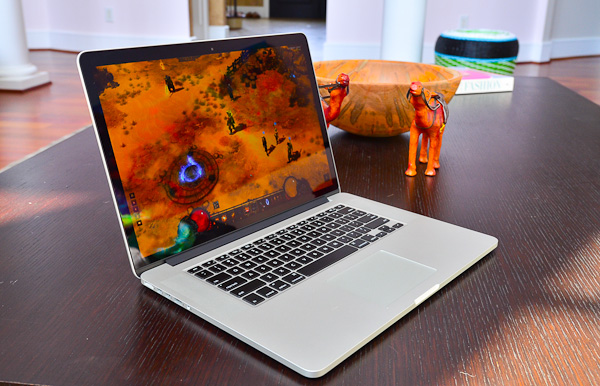
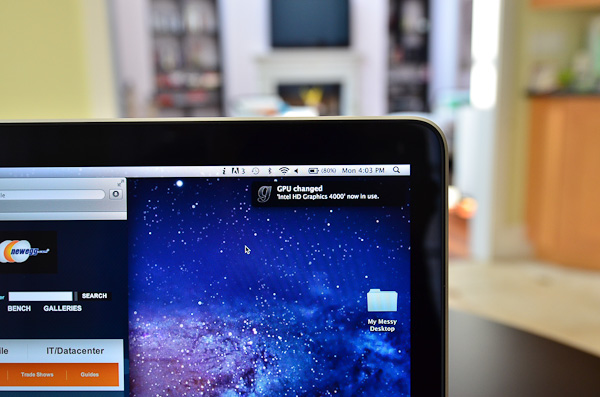








471 Comments
View All Comments
OCedHrt - Sunday, June 24, 2012 - link
Sony can't exactly add better DPI scaling to windows, can they? That's Apple's advantage as being both the OS vendor and hardware vendor - better integration.ka_ - Saturday, June 23, 2012 - link
"Sony added 1080p because it was popular, not because it made sense"What a ridiculously ignorant and biased statement! Sony did surely not place a blue-ray players in the device for a reason neither... To place a 1080p display in the product made perfect sense, retina display on the other hand is a marketing buzzword. I am sure it looks better, but really - you wont find movies or much content that benefit from the retina display - they display will likely slightly distort the movie though you can say the distortion is so small you wont notice... 1080p on the other hand...
Donkeyz - Saturday, June 23, 2012 - link
Movies are not what the retina pro is targeting. Professionals of video and imaging need screen estate on a portable device as they travel. That is what the retina is for.We are talking about a 2012 device not 2008, but Sony use to be the best only because they played by marketing. Giving the best of the best and the looks.
Why apple works? Because they focus on individual needs and have excellent support, which may be why people are willing to pay excessive $$.
I own a Sony Z and my sister owns a MBP and I must say that Sony took 16 days to get the Z repaired where as MBP only took 2 days.
Some people may prefer a bluray drive but I don't use my drive at all. So it really depends, I'm replacing the Z with this MBP retina purely because of the screen estate for work and support.
Btw, as far as pricing goes, it's not expensive at all. To configure a pc of it's calibre would cost just as much and would most likely be made of plastic.
Freakie - Sunday, June 24, 2012 - link
To configure a PC that would handily kick this things ass would be cheaper, actually. To configure a Windows laptop that has a 6 core Desktop CPU and the best mobile GPU (as well as two hard drives) would cost the same as the basic model of this. Throw in 2 more hard drives for a total of 4 hard drives, and add a second GPU in SLI or CrossfireX, and you're at the price of the high end model of this.And yeah, things get repaired faster with Apple, though I bet you I could have fixed your Sony in a matter of hours. Difference is you can go to someone in real life for cheap to get your Mac looked at, but if you actually know what the f*ck you're doing, you don't need to take any laptop to anyone.
And if you are a media editor focused more on screen real estate instead of quality, then you fail miserably. Screen space comes second to color representation, space, and accuracy as well as ease of transitioning between different lighting and color profiles. Do displays that have amazing color representation come in high resolution? Yes! Because they are great things to pair together. Do high resolution displays have great color representation? NO! As is proven by this rMBP, just because you have high resolution doesn't mean that you have great colors. And compared to those color displays that have a high resolution, this rMBP screen sucks royal ass for media editing.
You'd be much better off getting a faster PC laptop and using the money you save on a screen that will actually enable your media to come out much better (if you are a media editor). Not only that, but your PC will get the work done faster than the MBP (better hardware, cheaper price)
vegemeister - Monday, July 2, 2012 - link
>laptop that has a 6 core Desktop CPU and the best mobile GPU (as well as two hard drives)Yeah, but that would be retarded.
mlambert890 - Wednesday, November 28, 2012 - link
You understand that the concept of a laptop is to be portable right? WHAT are you talking about? The PC you're describing I own - AWM18x. It is 13 lbs.This is like saying, essentially, that size and weight (and noise) are irrelevant dimensions in a notebook.
They are the *only* relevant dimensions. And this is like horsepower. A 600HP car isnt "a mere" 150HP more than a 450HP car. That 150 extra HP is HARD and EXPENSIVE.
Similarly, people like you, who say "well that PC would "only" be 3 lbs heavier!" are just displaying how clueless you are with what matters in this segment.
Show me this mythical PC laptop that is 4.5lbs with discrete graphics, SSD, quad core i7 and 15" 1080p screen or greater yet is much cheaper than the MBPr. Let's see it.
ka_ - Sunday, June 24, 2012 - link
"Why apple works? Because they focus on individual needs and have excellent support, which may be why people are willing to pay excessive $$."Fine, so you say MBP is a niche product, that is meant for niches such as video editing, graphics design and so on. Your CEO, sales teams, financial staff and so on will not go buy it because they have no need for this and will not fall for the hype of having the next buzzword "Retina Scan" which they have absolutely no need for. Sure I believe you...
1080p on the other hand make much more business sense as Sony not only sell technology like Blue Ray players but is in the Music and Video industries too. They get paid for each movie sold on blue ray too - and 1080p is today mainstream, not niche!
I highly doubt more than a small percentage of those who will buy the MBP actually get it for a real need and not due to marketing hype...
OCedHrt - Sunday, June 24, 2012 - link
That's the issue. When you have a 2880 x 1800 screen, you forget that most of the internet users are on 1368 x 768. and 1600 x 900. What you design may look awesome to you but it does not scale well for your audience.For print work, I agree 2880 x 1800 is awesome.
Ohhmaagawd - Saturday, June 23, 2012 - link
" retina display on the other hand is a marketing buzzword. I am sure it looks better, but really - you wont find movies or much content that benefit from the retina display"Umm. What about ANYTHING with text?
What about Photos?
What about ability to edit 1080p in full res with all your editing controls on the screen next to it?
What about Photoshop?
Freakie - Sunday, June 24, 2012 - link
What about photo and video editors that don't use the display on any laptop, period? Media editors want color quality first, not resolution, which this screen fails at. Media editors will still use their $1,000 monitors at their desk to do their edits.